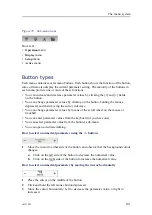
Echo sounder theory
if there is real fish below the keel. The number provided to display fish abundance is
relative, and after some use your experience will be a valuable factor when the decision
is made.
The biomass value is also used by the researches to calculate how much fish there is in
the ocean. If you know the fish specie and the size of the fish, you can calculate number
of individual fishes for a given volume of sea. Other means to establish the final result
are trawling and catch data from the fishery community.
Note
If you have other echo sounders or sonars running asynchronous with the ES70, the
ES70 will also measure the transmit pulse from the secondary system. This is called
interference.
You can remove the interference using the
Ping-Ping Filter
function on the
Active
menu, but
the ES70 receiver will still pick up the transmit pulse and implement it in the calculations.
A full synchronization of the various acoustic instruments is required. If your own vessel
produces excessive noise this will also be taken into the biomass calculations and
provide you with inaccurate information.
Related topics
•
on page 57
•
on page 59
About TVG gain
TVG means
Time Varied Gain
. When TVG is used in
an echo sounder, we also some times refer to it as
depth
variable gain
.
The purpose of the TVG functionality is to make all
fishes appear with the same echo colour independent
of their different depths.
In more technical terms, time varied gain (TVG) is a
signal compensation. When the acoustic signal is transmitted from the echo sounder
transducer, it is subjected to loss due to
absorption
and
spreading
. First, depending on
the current salinity and temperature, the water will absorb some of the energy from the
transmission. The absorption loss increases as the range increases. Second, the energy
will spread out to form a circular beam. The width of this beam also increases with
the range. Both absorption and spreading will thus reduce the energy, and both will
also have an effect on the returned echo signal. The TVG compensation is designed to
counteract these natural phenomena, and this is done in the ES70 using digital signal
processing. The desired result is that fish of the same size return echoes of the same
strength (colour), regardless of range.
343539/B
109
Summary of Contents for ES70 - DOWNLOAD AND INSTALLATION REV B
Page 2: ......
Page 128: ...ISBN 13 978 82 8066 118 0 2010 Kongsberg Maritime AS ...
































